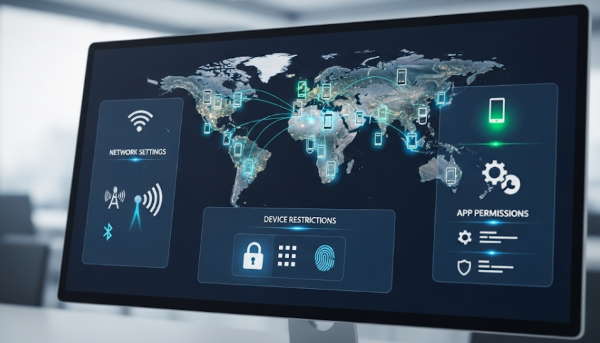Say you just hired 200 new remote employees across different continents and time zones. Each one needs a phone set up with VPN access, security protocols, and about a dozen internal apps.
You then look at your two IT specialists and ask: “How are we doing this?”
Scaling is a good problem to have for enterprises worldwide, but it’s still a problem. Remote work has turned mobile devices from "nice to have" into absolute business essentials. Unfortunately, traditional IT management wasn't built for this reality.
So, how exactly can IT departments configure hundreds or thousands of phones efficiently without losing their sanity?
The answer involves fundamentally rethinking how we approach device management in an era where your office might be someone's kitchen table in Portland, a coffee shop in Austin, or a coworking space in Barcelona.

1What Is Mobile Phone Configuration in an Enterprise Context?
Mobile phone configuration in the enterprise world is the art of turning a consumer device into a business-ready machine.
Think of it as the difference between a regular car and a company fleet vehicle. They have the same basic function, but one comes with GPS tracking, usage monitoring, and strict rules about where you can drive it.
At its core, configuration involves setting up device policies, app permissions, connectivity settings, and security protocols.
This isn't your typical "connect to Wi-Fi and download Instagram" setup. We're talking about enterprise-grade controls that ensure devices comply with company standards and regulatory requirements.
The difference between user-level and IT-level configuration is like the difference between decorating your apartment and rewiring the electrical system.
Users can change wallpapers and rearrange apps, but IT controls the foundational settings that determine what apps can be installed, which networks can be accessed, and how data flows through the device.
Enterprise configuration covers everything from basic connectivity settings like Wi-Fi and VPN to advanced security measures like encryption protocols and remote wipe capabilities.
It's the invisible infrastructure that makes business mobility possible while keeping the cybersecurity team from having daily panic attacks.
2Why Scaling Mobile Phone Configuration Is Challenging?
Managing mobile phone configuration at scale presents several critical challenges:
- Configuring Devices Across Distributed Teams: Remote work has scattered teams across time zones, making coordinated device setups nearly impossible. Distributing that urgent security update becomes difficult when everyone needs to be online simultaneously to receive it.
- Manual Setup Time and Errors: Each device takes 2-3 hours to configure manually. With 100 devices, you're looking at 200-300 hours of repetitive work. Human error is inevitable when repeating the same steps dozens of times.
- Security Policy Enforcement: Manually enforcing consistent security policies across hundreds of devices is like herding cats. Different operating systems, versions, and user behaviors create unique security risks, while compliance requirements keep getting stricter.
- Lack of Visibility or Audit Trails: Without proper configuration management, IT teams fly blind with no idea which devices are properly configured or vulnerable. Manual processes make audit trails impossible to maintain.
3How MDM Helps IT Configure Mobile Devices at Scale?
Bulk Enrollment & Zero-Touch Provisioning
Zero-touch enrollment is the ultimate "set it and forget it" approach to device management. Devices can be pre-configured with company settings before they even ship.
The moment an employee powers on their new phone, it automatically connects to your MDM system and downloads all necessary configurations.
Provisioning templates let you create configuration profiles once, then apply them to hundreds of devices automatically.
Sales gets CRM apps, accounting gets expense tracking software. No more conference calls walking people through 47 different settings screens.
Remote Policy & Settings Management
MDM solutions let you configure Wi-Fi settings, VPN connections, and app restrictions from a central console without touching physical devices. It's like having a remote control for every phone in your organization.
Policy updates are pushed instantly to all devices. Need to update the company Wi-Fi password? It's done in seconds across 1,000 devices. New security requirement from compliance? Push the updated policy to everyone simultaneously.
Security & Compliance Controls
Password policies can be enforced automatically. Device encryption becomes mandatory rather than optional. Remote wipe capabilities mean lost devices can be completely cleared within minutes.
Unauthorized app blocking prevents the installation of anything not on your approved whitelist. Compliance controls can be automated to meet HIPAA, GDPR, SOX, or whatever regulatory requirements your industry demands.
Application & Content Deployment
App deployment through MDM is like having your own business-approved app store.
Business can remotely upload, install and uninstall apps to target device groups remotely. Or deploy apps from Managed Google Play Store directly.
Silent app installations mean business applications simply appear, properly configured and ready to use. It's like having an invisible IT assistant.
Monitoring, Reporting & Troubleshooting
Real-time dashboards give IT teams the visibility they've been lacking. You can see which devices are properly configured, which ones have issues, and which employees need additional security training.
Alert systems notify IT teams immediately when devices are out of compliance. Remote troubleshooting capabilities mean you can resolve device issues without requiring user intervention.
4Types of Mobile Phone Configuration for Different Usage
The way you configure mobile devices depends entirely on how your organization operates. Different business models have completely different security and functionality requirements, requiring tailored configuration strategies.
Corporate-Owned, Personally Enabled (COPE)
COPE offers a balanced approach. Organizations provide the hardware, and employees use it for both business and personal purposes. That kind of setup gives IT full device-level control while still allowing some flexibility for personal use.
Configuration here focuses on creating secure, segmented environments. For instance, business apps can be containerized and subject to strict policies, while personal apps operate independently with limited permissions.
Use case: In one field deployment case, a financial services company used COPE-configured devices with AirDroid Business to restrict devices to a banking app, enforce camera/microphone access for ID verification, and disable external storage. Geofencing and real-time monitoring helped the team track activity and maintain compliance, even as devices were used in mixed business-personal contexts.
Fully Managed Corporate Device
This model has the tightest restrictions. Devices are fully controlled by the organization and used strictly for business operations. There's no personal use, with every setting, app, and feature centrally managed.
In the energy sector, an HVAC company used fully managed tablets for field technicians. AirDroid Business allowed them to deploy dispatch and diagnostic apps remotely, restrict access to only essential tools via Kiosk Mode, and maintain real-time visibility into device performance. Silent updates ensured every device ran the latest software without technician involvement.
Use case: A ticketing center configured devices to run only POS and validation apps, connected to a specific APN to prevent disconnection, and disabled all other network options. These fully managed devices ensured fast, secure operations in busy venues.
5What Are the Key Requirements for Scalable Configuration?
Scalable Android configuration and mobile device management require three fundamental capabilities that work together seamlessly:
- Central management console: This dashboard serves as mission control for your entire device fleet. It's a comprehensive platform where IT teams can create policies, deploy applications, monitor compliance, and troubleshoot issues across thousands of devices from a single interface.
- Remote configuration capabilities: These eliminate the need for physical device access. Everything from Wi-Fi settings to security policies can be configured and updated over the air. Remote management extends to troubleshooting, app deployment, and even device retirement when employees leave the organization.
- Compliance support: Support for regulations like HIPAA, GDPR, SOX, and industry-specific requirements isn't optional anymore. Your MDM solution needs built-in compliance templates, automated reporting capabilities, and audit trail functionality that can satisfy regulatory requirements without requiring manual documentation processes.
These requirements work together to create a scalable system that grows with your organization while maintaining security and compliance standards. Without all three elements, gaps will develop that become bigger problems as your device fleet expands.









Leave a Reply.